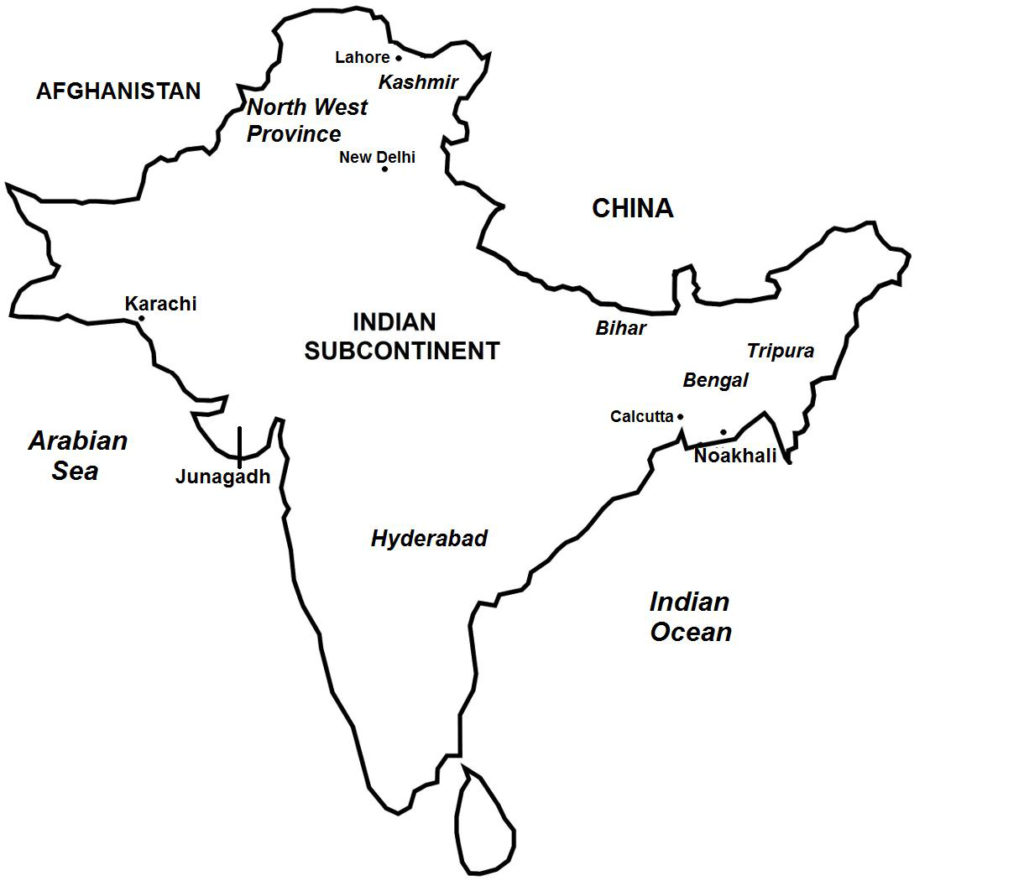On August 16, 1946, mass riots and widespread violence and destruction broke out in Calcutta (present-day Kolkata) in Bengal Province, British India. When the chaos ended three days later, over 4,000 people had been killed and 100,000 others left homeless. The carnage was the worst ever experienced in British India.
The violence arose when the Muslim League, a political party advocating for the formation of a separate Muslim-majority sovereign state in British India, called for a general strike following the breakdown of independence talks with their rival, the Indian National Congress, within the 1946 Cabinet Mission to India. The talks were intended to resolve the contentious issues relating to the partition of the Indian subcontinent.
In the aftermath of the Calcutta incident, a spate of sectarian violence broke out in other regions: Noakhali, Bihar, United Provinces (modern Uttar Pradesh), Punjab, and the North Western Frontier Province.

(Taken from Partition of India – Wars of the 20th Century – Volume 3)
Background At the end of World War II, Britain was reeling in heavy debt and was facing economic ruin. The British government was hard pressed to continue financing the many British overseas colonial administrations in its vast territories around the world. Britain therefore adopted a foreign policy of decolonization, that is, the British would end colonial rule and grant independence to the colonies. Britain’s decision to decolonize also was influenced by the rise of nationalism among colonized peoples, a phenomenon that occurred in British, as well as other European colonies around the world.
In the Indian subcontinent (Map 12), which was Britain’s prized possession since the 1800s, a strong nationalist sentiment had existed for many decades and had led to the emergence of many political organizations that demanded varying levels of autonomy and self-rule. Other Indian nationalist movements also called for the British to leave immediately. Nationalist aspirations were concentrated in areas with direct British rule, as there also existed across the Indian subcontinent hundreds of semi-autonomous regions which the British called “Princely States”, whose rulers held local authority with treaties or alliances made with the British government. The Princely States, however, had relinquished their foreign policy initiatives to the British in exchange for British military protection against foreign attacks. Thus, the British de facto ruled over the Princely States.
For so long, the Indian nationalist movement perceived the British presence as impinging on the Indians’ right to sovereignty. Ultimately, however, India’s religious demographics – the divide between the majority Hindu Indians and the minority Muslim Indian sectors of the population – would be the major obstacle to independence. Hindus constituted 253 million people, or 72% of the population, while Muslims, at 92 million, made up 26% of the population. Sikhs, who were concentrated in Punjab Province, totaled about 2 million, or 6% of the population.
In the first few decades of the twentieth century, Hindus and Muslims were united in their common opposition to British rule. By the mid-1930s, the British had allowed native participation in politics and government, hinting at India’s likelihood of gaining independence. Muslim Indians now became concerned, since an independent India meant that Hindus, because of their sheer number, would have a perennial held on power. To the Muslims, this would mean a permanent Hindu-dominated India where Muslim interests possibly would not be met.
Muslims, therefore, proposed to carve out a separate Muslim state, which would be called “Pakistan” and would consist of regions that contained a majority Muslim population. However, such a proposal, which emerged in the 1930s, was considered too radical even for most Muslims, since the idea of a divided India was inconceivable. Most politicians from the two sides were intent on trying to work out a power-sharing arrangement at all levels of government, much like the local autonomous governments, which by now had come into existence and were run jointly by Muslims and Hindus.
By 1940, however, Muslim Indians were advocating the “Two-Nation Principle”, that is, since Hindus and Muslims belonged to different religions, they also differed in nationality, even if they shared a common ethnicity, culture, and language. Even then, most Muslim leaders only used the Two-Nation Principle as a means to gain greater political concessions in their support for an undivided India. Hindus were intractably opposed to partitioning India.
In May 1946, the British central government in London sent to India a delegation called the “Cabinet Mission” with the task of finalizing the process of granting India’s independence and to transfer all governmental functions from the colonial administration to a new Indian government consisting of Hindus and Muslims. Britain envisioned an undivided India, and the Cabinet Mission therefore was instructed to work out a power-sharing government for Muslims and Hindus.
In June 1946, the Cabinet Mission presented a plan for an Indian federated state made up of separate, autonomous Hindu-majority and Muslim-majority provinces under a decentralized national government. Muslim political leaders accepted the plan, reasoning that the decentralized scheme met their demands for self-rule. However, Hindu leaders rejected the plan, arguing that it essentially partitioned India into many smaller states.
Hindu leaders then proposed to amend the plan into one that included a strong centralized government. Muslim leaders were infuriated and walked out of the proceedings, and subsequently withdrew their support for the Cabinet Mission. They then called on Muslims to hold civil actions. Across India, Muslims carried out mass protests and demonstrations, which generally ended without incident. However, in Calcutta on August 16, 1946, an initially peaceful assembly turned violent when armed bands of Muslims and Hindus went on a rampage, and for three days, carried out widespread violence and destruction. When British troops finally arrived and restored order, over 5,000 persons had been killed, 10,000 wounded, and tens of thousands left homeless. The majority of the victims were Muslims.
